“Once the material was in position, we had to lock it in quick,” says Adam Brown, president of Sign Effectz, Inc., in Milwaukee, Wisconsin. “We didn’t want this big ‘kite’ just floating around up there.”
Brown is referencing two new rooftop 40-by-40-foot, 300-pound sign face graphics that his shop installed this past August in downtown Milwaukee. This project scope also included a massive structure to support two monster graphics.
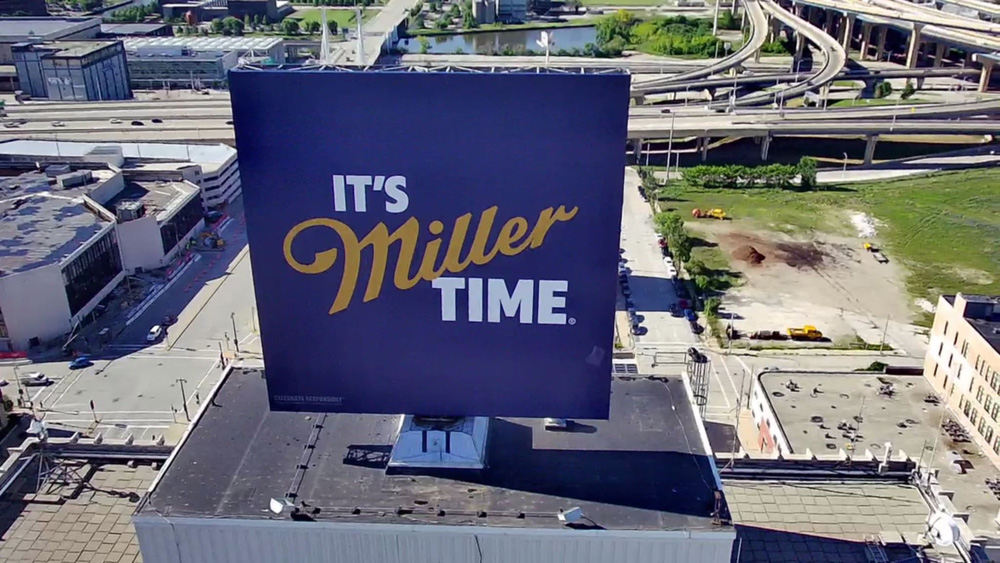
The building owner originally asked the custom sign manufacturer to switch out a rooftop rotating sign for a previous client that had stopped operating with stunning new graphics for his new leasee, Miller Brewing Company. The two graphics were printed on eighteen-ounce Panaflex material—one features their logo (“It’s Miller Time”) and the other a promotional photo.
Sign Effectz started by surveying, analyzing, and determining the engineering required for this new, double-face rooftop sign. As the previous structure was designed and erected in 1967, it needed a very detailed structural analysis. Sign Effectz was able to find microfilmed construction documents for the original sign—technical drawings without a computer and engineering all done long hand. “The documents are true works of art,” says Brown.
The only part of the previous sign remaining was a twenty-foot-tall, triple-walled steel pole structure, part of the super structure that is still in place. “Word on the site was that there was somewhere around 100,000 pounds worth of steel supporting this beast,” says Brown.
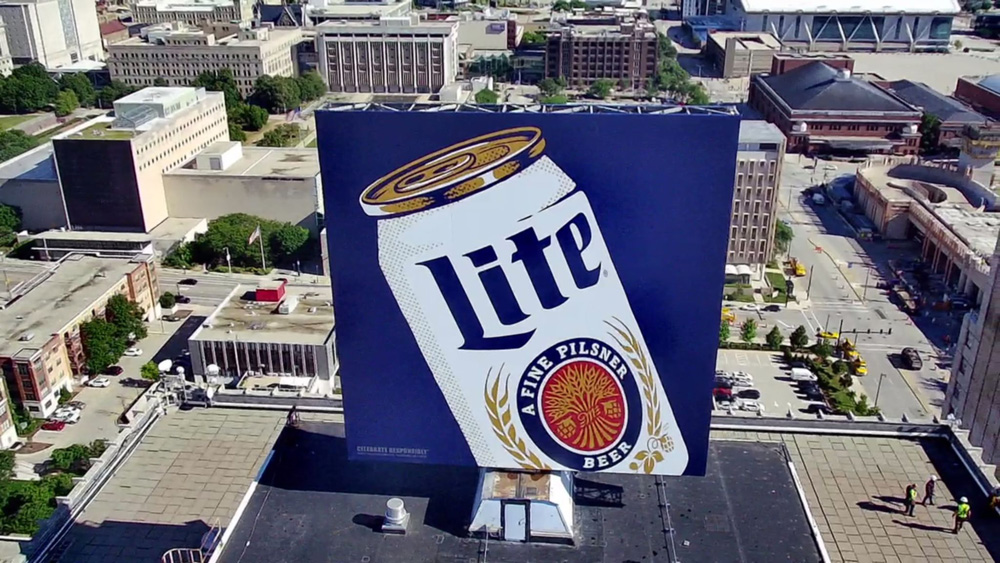
Using the steel pole structure as support, Sign Effectz ended up engineering and fabricating eight five-foot-tall-by-four-foot-wide-by-forty-foot-long sections out of select steel angle iron. When the top frame was welded together, it also served as the vehicle to host the 600 pounds of graphics panels on the top. “Just building one section in the shop takes up so much room that it made operations in the shop a bit tight,” says Brown. “We built them in front of our overhead garage doors so they could be carted outside as soon as each section was complete.”
The eight framework sections were transported to the site via two semi low-boy trailers (four of each stacked together on the truck).
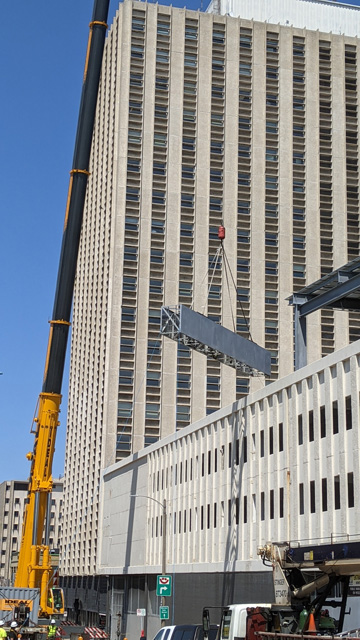
Sign Effectz hired Ideal Crane Service with a 550-ton mobile crane and a 325-foot reach, along with a man basket to get the job done. It took an entire city block to get the positioning and angle just right. “Load-wise, the crane was rated for 27,000 pounds at our final set up. Each frame section only weighed about 3,000 pounds, so we had plenty of lift capacity,” says Brown.
However wind speeds were going to play an important role in not only the lift of the framework section and the install of the Panaflex sign faces but also what days and times they could get it done. “It turns out 11pm to 4am was the sweet spot with regards to finding the optimal wind speeds,” says Brown.
Sign Effectz used a subscription-based app intended for flying drones that forecasted and monitored the weather and wind speeds at a 294-foot elevation over a seven-day period. “Your standard weather reports typically report at a thirty-three feet elevation,” says Brown. “Weather is quite different when you’re up above the city. You must go when Mother Nature allows. After all, she’s in charge. Fifteen-miles-per-hour wind was the threshold, and this app gave us the best times for ideal wind speed at our needed height. It reports all the way up to 5,000 feet and is very accurate compared to your standard weather band forecast.”
With wind speed times calculated, Sign Effectz next needed to address how to make sure the steel framework and rolled graphics were successfully hoisted atop the roof. Because of his position and late-night visibility, the ground-based crane operator was not going to have a clear line of sight and needed direction.
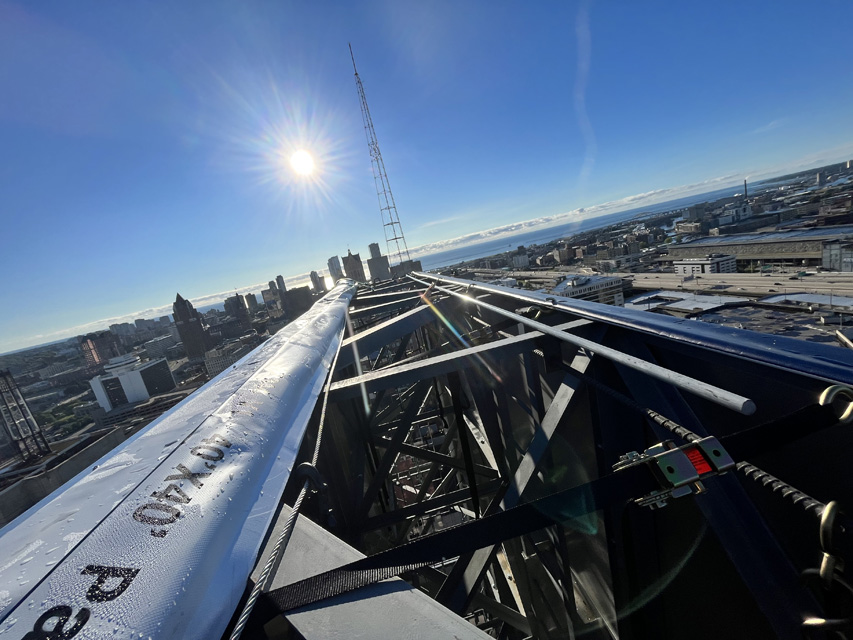
The solution: Designating three team members at various locations communicating with the crane operator via Bluetooth headsets and cellphones. Two were on the roof and one was on a parking garage adjacent to the building. One would take over when the other’s aerial line of sight ended. “It was a sort of “leap frog” style of communication, ensuring they always knew where the lift was and how it was reacting to conditions,” says Brown.
The steel sections were lifted one at a time and placed over the pole. “Half of them sleeved entirely over the pole,” says Brown. “We had to bolt together the remaining top four sections in the sky, which made alignment a little more difficult, only using tag lines, drift pins and hardware to secure in place.”
About 1,500 feet of taglines and rope were used to hoist the frames in place during its installation and had a similar “leap frog” approach to the lifting process.
Another challenge was the fire hazard below the signs. The elevator operating room featured a lot of oil and grease from the previous rotating mechanism, which meant welding and torching were out until it could be sealed and isolated from the potential fire hazard. As the new sign was not going to rotate any longer, all the pipe and pivot bearing materials had to be removed.
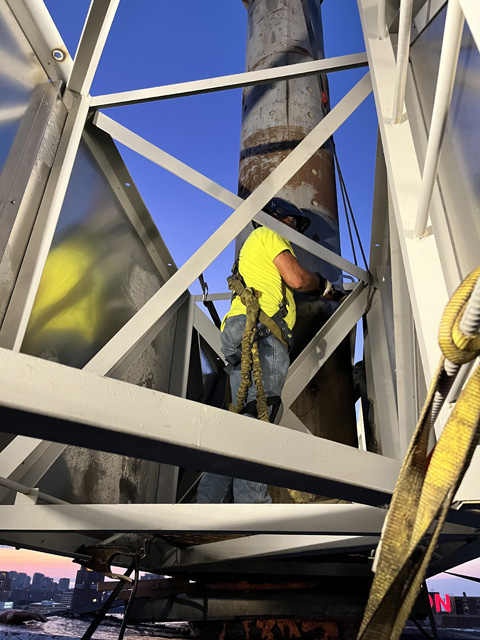
Sign Effectz used reciprocating saws and special carbide blades to prep the pole structure and eliminate the potential of sparks or flames. They also assigned somebody to be on “fire watch” inside the room at all times. They filled any openings created from the removed rotating parts with fire-rated expanding foam and covered everything with fire blankets as another level of protection to isolate the fire-sensitive area.
A unique engineering feat was incorporating a series of ladders, jack lines, and catwalks inside the framework while building it at their shop. It had to allow for the workers to later access the top of the structure safely. “The only improvement I would’ve made is placing a catwalk across the top,” says Brown. “The triangulated pattern of the frame itself made it a little harder to get across from one end to the other.”
The graphics were next in line and already hoisted in place with the final top frame. Then workers at the top of the assembled spaceframe structure rolled the massive graphic downward off its edge. “It was like a 300-pound sail or flag dropping down,” says Brown.
Brown says they had to think of this as like preparing a parachute for deployment. “It had to be folded just right so it wouldn’t tangle up or get jammed in a bundle when we unfurled it,” he explains, “or we’d have to drop it all down to the roof and start over.”
The Panaflex graphics were installed very similar to a billboard, using a ratchet-and-rod system. “The vinyl has a pocket in it all the way around the perimeter,” says Brown. “We slid fiberglass rods into the pockets, quickly ratcheted it in place to ensure it was secure, then moved to working out the wrinkles”
This was the first time most of Brown’s installers had worked in a high-rise environment like this, so he had to develop an entire site safety plan for the job that included daily safety meetings, inspection of gear, and fall recovery plans. He also had to ensure all the proper fall protection and fall recovery gear was in place. Daily meetings kept team members on point and from potentially becoming complacent with the high elevation environment. (Note: There was no railing or barrier on the roof to protect from falling.)
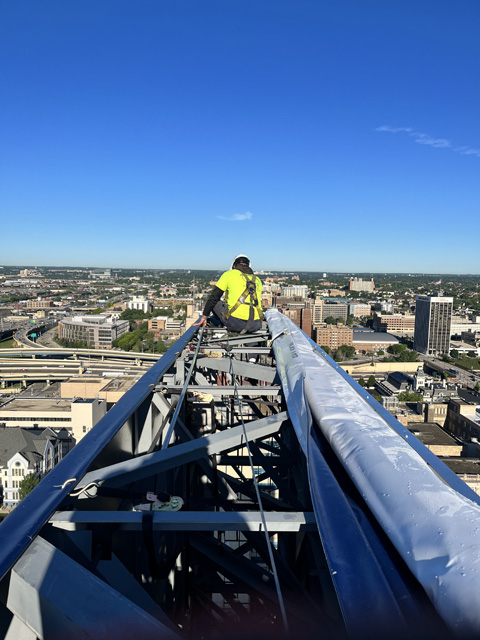
The fall recovery plan came with three options to rescue any workers that might fall during the installation (man basket and crane rescue, a recovery ladder over the edge of the sign, and repelling gear to access anyone unconscious). Fortunately none these options were needed.
“They all took it seriously and did a phenomenal job. They all understood the risk involved and were super-perfecto. I’m incredibly proud of them!” says Brown.
—Jeff Wooten










